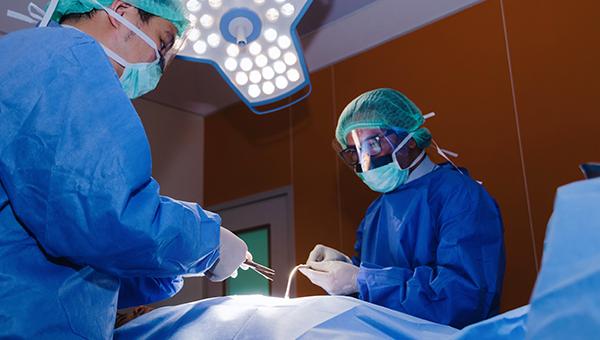Intravascular Lithotripsy May Facilitate TAVI in Patients With PAD
The method could eliminate over 60% of alternative access, allowing TAVI to be done femorally, says Chandan Devireddy.

PAD patients with severe calcification of the external and common iliac arteries who require TAVI can undergo a successful delivery of the device when it is facilitated by pretreatment with intravascular lithotripsy, a new study suggests.
Senior author Carlo Di Mario, MD, PhD (University Hospital Careggi, Florence, Italy), said in an email that the study more than doubles the patient experience reported so far with this technique and illustrates “successful transfemoral delivery of TAVI in patients with severe calcification of the external and common iliacs that were otherwise due to require alternative approaches.”
Chandan M. Devireddy MD, MBA (Emory University Hospital Midtown, Atlanta, GA), who was not involved in the study, said the results show that it is possible to “essentially eliminate 66% of those alternative cases and allow them to be done in a transfemoral method that mimics the strategy and the clinical care pathway that I think delivers the best results that we can achieve with TAVR.”
Devireddy was the senior author on one of the only other registry studies of lithotripsy to facilitate TAVI, which consisted of 42 patients treated at one of four centers in the US and Italy. In that study, successful transfemoral TAVI was performed in more than 90% of patients, with no iliofemoral arterial perforation or dissection requiring stent implantation.
To TCTMD, he said the paper by Di Mario and colleagues, which was led by Giulia Nardi, MD (University Hospital Careggi, Florence, Italy), expounds on the technique and its generalizability in practice, and provides needed data for heart teams. In addition to the two registry reports, the only other mentions in the literature of lithotripsy used in this way come from scattered case reports.
“We've already developed over the last 10 years a sense of who is not suitable for a routine transfemoral access,” Devireddy observed. “In the patients that we're identifying as higher risk for prohibitive vascular access, we have to figure out who would benefit from intravascular lithotripsy upfront and who has such small-caliber vessels, or such heavy burden of diffuse calcification or other high-risk features within the vasculature, that using this device will still have a low likelihood of success.”
Di Mario added that the good safety results, combined with operator experience and confidence, are likely to result in a drop in rates of general anesthesia, which some centers routinely use in anticipation of the need for conversion to emergency vascular surgical repair in these patients.
Fracturing and Facilitating
For the study, published November 4, 2021, in EuroIntervention, Nardi et al examined data on 108 patients who underwent intravascular lithotripsy-assisted TAVI at six high-volume European centers between 2018 and 2020. Reference vessel diameter was 9.1 mm, target lesion minimum diameter was 4.6 ± 0.8 mm with an average diameter stenosis of 50.0% ± 10.7%, and the mean calcification length was 50.5 mm. Femoral access was achieved in 101 patients, with the remaining seven patients requiring surgical cutdown. TAVI valves used included SAPIEN 3 and SAPIEN Ultra (Edwards Lifesciences), Evolut R and Evolut R PRO (Medtronic), and Portico (Abbott).
The decision to use intravascular lithotripsy up front or as a possible bailout in a case of unsuccessful initial delivery was left to individual operators, as was the option to predilatate or postdilatate. In the majority of cases, a 7-mm intravascular lithotripsy balloon catheter (Shockwave Medical) was used and the maximum available cycle of impulses (n = 300) was delivered. Over the study period, intravascular lithotripsy-assisted TAVI increased among the participating centers from 2.4% in 2018 to 6.5% in 2020. At the same time, the use of alternative approaches for TAVI delivery, including transsubclavian and transapical accesses, decreased from 8.7% to 3.0%.
TAVI implantation success was 98.2%, with two conversions to open cardiac surgery. There was one perforation of the external iliac artery as well as three type F major dissections requiring stent implantation. All were detected by angiography immediately after dilatation and were described by the investigators as “easily treatable.” Access-site complications consisted of closure device failure (5.9%), dissection (1.8%), and major bleeding (2.8%). These complications led to unplanned endovascular interventions in 12% of cases.
Of seven dissections related to the intravascular lithotripsy procedure, four were in patients who underwent predilatation prior to lithotripsy versus three in patients with no predilatation (P < 0.0001).
To TCTMD, Devireddy said he tries to avoid pre- and postdilatation when doing these procedures.
“The mechanism of changing the morphology of these vessels to allow large-bore catheters and sheaths to pass is through the fracture of calcium in the vessel wall. It’s not about mechanically expanding the vessel with the balloon,” he said. “I've actually become much more conservative since the very first cases we did 3 years ago in terms of getting the balloon just large enough—typically just at 3 or 4 atmospheres—so that I have volume in the balloon to deliver the high-pressure sound waves emitted by the Shockwave balloon.” Devireddy added that typically what is seen is a “dog bone” appearance to the balloon, followed by a disappearance of the compressed center of the “bone” as the plaque fractures.
Di Mario said pressures of 4 to 6 atmospheres appear to cause minimal damage to the vessel wall, avoiding large spiral flow-limiting dissections and perforations. Additionally, he said the recent availability of a larger 8-mm PAD intravascular balloon that can deliver the same energy in half the time of the previous balloons will likely reduce the need for operators to use noncompliant balloons, simplifying the procedure.
L.A. McKeown is a Senior Medical Journalist for TCTMD, the Section Editor of CV Team Forum, and Senior Medical…
Read Full BioSources
Nardi G, De Backer O, Saia F, et al. Peripheral intravascular lithotripsy of iliofemoral arteries to facilitate transfemoral TAVI: a multicentre prospective registry. EuroIntervention. 2021;Epub ahead of print.
Disclosures
- Nardi reports no relevant conflicts of interest.
- Di Mario has received research or educational grants from Abbott, Amgen, Asahi Intecc, AstraZeneca, Boston Scientific, Cardinal Health, CSL Behring, Chiesi, Daiichi Sankyo, Edwards, Medtronic, Menarini, Pfizer, Sanofi, Shockwave, Teleflex, and Volcano/Philips.
- Devireddy reports having consulted for Shockwave, Medtronic, Recor Medical, and Vascular Dynamics; and proctoring for Edwards Lifesciences.





Comments